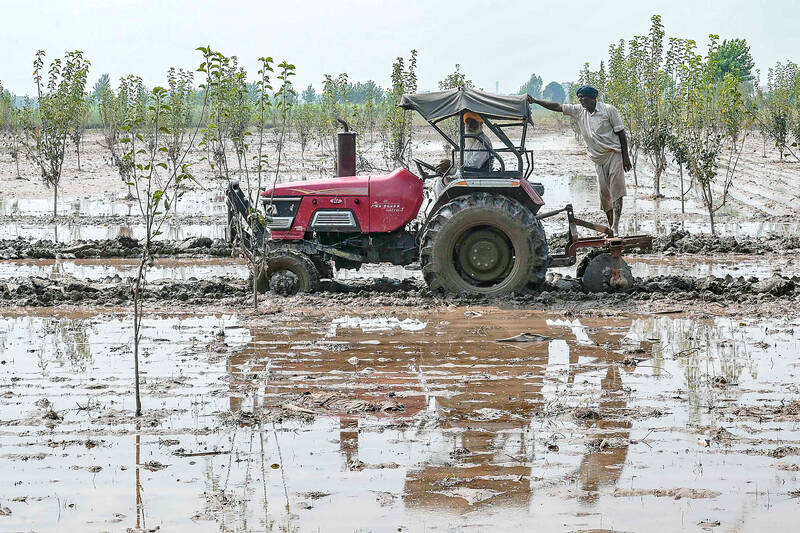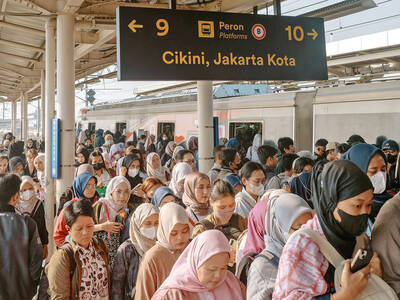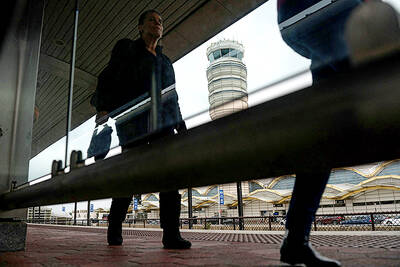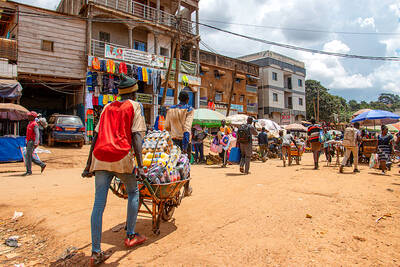The fields are full, but the paddy brown and wilted, and the air thick with the stench of rotting crops and livestock — the aftermath of record monsoon rains that have devastated India’s breadbasket.
In Punjab, often dubbed the nation’s granary, the damage is unprecedented: Floods have swallowed farmlands almost the size of London and New York City combined.
India’s agriculture minister said in a visit to the state that “the crops have been destroyed and ruined,” and Punjab’s chief minister called the deluge “one of the worst flood disasters in decades.”

Photo: AFP
Old-timers agree.
“The last time we saw such an all-consuming flood was in 1988,” said 70-year-old Balkar Singh in the village of Shehzada, 30km north of the holy Sikh city of Amritsar.
The gushing waters have reduced Singh’s paddy field to marshland and opened ominous cracks in the walls of his house.
Floods and landslides are common during the monsoon season on the subcontinent, but experts say climate change, coupled with poorly planned development, is increasing their frequency, severity and impact.
Punjab saw rainfall surge by almost two-thirds compared with the average rate for last month, according to the national weather department, killing at least 52 people and affecting more than 400,000.
Indian Prime Minister Narendra Modi has announced a relief package of about US$180 million for Punjab.
The village of Toor, sandwiched between the Ravi River and Pakistan, is in tatters — strewn with collapsing crops, livestock carcasses and destroyed homes.
“The water came past midnight on Aug. 26,” farm worker Surjan Lal said. “It rose up to at least 10 feet [3m] in a matter of minutes.”
Lal said the village in Punjab’s worst-affected Gurdaspur District was marooned for nearly a week.
“We were all on rooftops,” he said. “We could do nothing as the water carried away everything from our animals and beds.”
In adjacent Lassia, the last Indian village before the frontier, farmer Rakesh Kumar counted his losses.
“In addition to the land I own, I had taken some more on lease this year,” the 37-year-old said. “All my investment has just gone down the drain.”
To make things worse, Kumar said, the future looked bleak.
He said he feared his fields would not be ready in time to sow wheat, the winter crop of choice in Punjab.
“All the muck has to first dry up and only then can the big machines clear up the silt,” he said.
Even at the best of times, bringing heavy earthmovers into the area is a tall order, as a pontoon bridge connecting it to the mainland only operates in the lean months.
For landless laborers like 50-year-old Mandeep Kaur, the uncertainty is even greater.
“We used to earn a living by working in the big landlords’ fields, but now they are all gone,” Kaur said.
Her house was washed away by the water, forcing her to sleep in the courtyard under a tarpaulin sheet — an arrangement fraught with danger as snakes slither all over the damp land.
Punjab is the largest supplier of rice and wheat to India’s food security program, which provides subsidized grain to more than 800 million people.
Analysts say this year’s losses are unlikely to threaten domestic supplies thanks to large buffer stocks, but exports of premium basmati rice are expected to suffer.
“The main effect will be on basmati rice production, prices and exports because of lower output in Indian and Pakistan Punjab,” said Avinash Kishore of the International Food Policy Research Institute in New Delhi.
Punishing US tariffs have already made Indian basmati less competitive and the floods risk worsening that squeeze.
The road to recovery for Punjab’s embattled farmers would be particularly steep because the state opted out of the federal government’s insurance scheme, citing high costs and a low-risk profile because of its robust irrigation network, analysts said.
Singh said the water on his farm was “still knee-deep.”
“I don’t know what the future holds for us,” he said.

FRUSTRATIONS: One in seven youths in China and Indonesia are unemployed, and many in the region are stuck in low-productivity jobs, the World Bank said Young people across Asia are struggling to find good jobs, with many stuck in low-productivity work that the World Bank said could strain social stability as frustrations fuel a global wave of youth-led protests. The bank highlighted a persistent gap between younger and more experienced workers across several Asian economies in a regional economic update released yesterday, noting that one in seven young people in China and Indonesia are unemployed. The share of people now vulnerable to falling into poverty is now larger than the middle class in most countries, it said. “The employment rate is generally high, but the young struggle to

ENERGY SHIFT: A report by Ember suggests it is possible for the world to wean off polluting sources of power, such as coal and gas, even as demand for electricity surges Worldwide solar and wind power generation has outpaced electricity demand this year, and for the first time on record, renewable energies combined generated more power than coal, a new analysis said. Global solar generation grew by a record 31 percent in the first half of the year, while wind generation grew 7.7 percent, according to the report by the energy think tank Ember, which was released after midnight yesterday. Solar and wind generation combined grew by more than 400 terawatt hours, which was more than the increase in overall global demand during the same period, it said. The findings suggest it is

IN THE AIR: With no compromise on the budget in sight, more air traffic controllers are calling in sick, which has led to an estimated 13,000 flight delays, the FAA said Concerns over flight delays and missed paychecks due to the US government shutdown escalated on Wednesday, as senators rejected yet another bid to end the standoff. Democrats voted for a sixth time to block a Republican stopgap funding measure to reopen government departments, keeping much of the federal workforce home or working without pay. With the shutdown in its eighth day, lines at airports were expected to grow amid increased absenteeism among security and safety staff at some of the country’s busiest hubs. Air traffic controllers — seen as “essential” public servants — are kept at work during government shutdowns, but higher numbers

Elvis Nghobo tried to get into four different professional schools in Cameroon, but could not make it. Frustrated, the 34-year-old turned to selling food at a market in Yaounde, the country’s seat of power. Nghobo blames his woes on what he calls a corrupt education system that favors children of the elite. As the central African country prepares for Sunday’s presidential election, he said he would not be heading out to vote. He called the results a foregone conclusion for 92-year-old Paul Biya, the world’s oldest president, who has ruled for Nghobo’s entire life. “He is already too old to govern, and it’s boring